Amid Blue Öyster Cult's Fictions, Forsaken Godless Revolutions
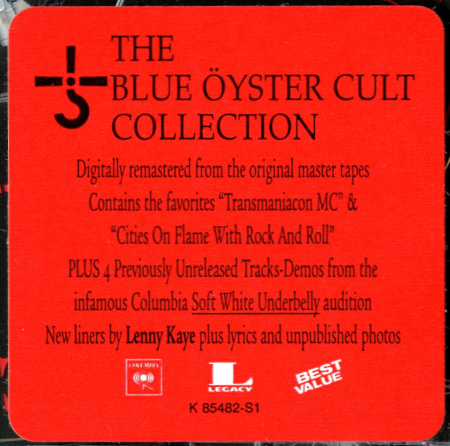
Blue Öyster Cult
Originally released 1972, reissued 2001 (Discogs) with four bonus tracks
Is there another "Classic Rock" band still befuddling listeners as much as Blue Öyster Cult? ("Classic Rock" here fitting a standard definition: the artists who were staples of F. M. radio, filled up arenas, and released album upon album of increasingly-refined music in the years, 1969-1982, trailing off after 1976.) The stories of countless such groups, even those quite obscure, are perennially regurgitated into stereotypical mush in the form of an endless trove of documentary films and glossy special issues of magazines. The Cult, on the other hand, seem like a... cult?—no, a secret society as much as a commercial musical operation. The band has its officiants and gate keepers among a small, aged cohort of devotees: An archivist, Bolle Gregmar, whose collection (a museum?) is largely out of the public eye; a devoted fan, John Schwartz, who wrote a Frequently-Asked Questions ("FAQ") text several years ago—in fact, a fine specimen of that briefly-flourishing, but hardly-missed, literary form—now preserved at the major Cult source of information in the present day, Hot Rails to Hull, a web site mostly serving as a gigography. The author of a book about the group, Martin Popoff, writes in his introduction that he hopes Gregmar will write his own book, deferring to the latter's deeper knowledge.
Let us put this another way—less esoteric? Blue Öyster Cult are not exactly Heavy Metal, Glam, Psychedelia, Punk, Progressive, or the groove-geared Rock of Z. Z. Top, Grand Funk Railroad, et al., but show traits of each. They are frequently placed in the Metal category, but that may be only because they were the first band to use the "Metal umlat" in their name or because they toured with Black Sabbath or because Eric Bloom wore a lot of leather on stage. (And the definition of Heavy Metal was very broad well into the Eighties.) Nonetheless the Cult's biggest hit, ‘(Don't Fear) The Reaper’, bridges the gap between Prog Rock and the A. O. R. mainstream of the late Seventies. Fittingly, in the ensuing years, there were times when they fit in best with the likes of Boston and Styx; not only that, they could beat those bands at their own game, especially on the underrated sixth studio album Mirrors. Or bore the influence of the post-Punk pop-Rock "New Wave", especially on ‘Burnin' for You’, the hit from the best of their later albums, their eighth, Fire of Unknown Origin. For those seeking to satiate any jonesing for vintage Seventies Rock, the Cult seem both to do it too well and to fail to fit the prescription for any defined genre. They are often forgotten, except for ‘Reaper’.
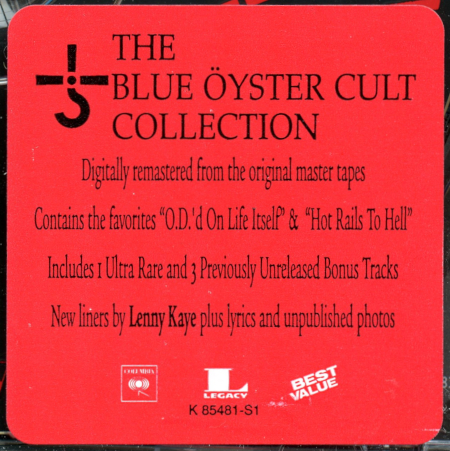
Blue Öyster Cult, Tyranny and Mutation
Originally released 1973, reissued 2001 (Discogs) with four bonus tracks
While Blue Öyster Cult are probably rarely grouped in with Progressive Rock, their Prog-like characteristics are helpful in appreciating their music. Contrary to the post-Bob Dylan Rock standard of a singer-songwriter singing his own songs, all five of Blue Öyster Cult's official members sang and composed; and several confidantes wrote lyrics: Sandy Pearlman, Richard Meltzer, Patti Smith, Helen Wheels. In other words, in the Cult's music, the lyricist is often not a member of the band, let alone the singer; and when a band member did write the lyrics, he did not necessarily take the lead on the finished track. The novice listener is forgiven for not knowing who's singing when. On the first-third albums, guitarist Eric Bloom sings more often than not, the others taking turns. (Bloom is the band's best singer, capable when he is not hewing too closely to Blues stylings of enacting surprisingly poignant moments, as in the song, ‘Veteran of the Psychic Wars’ from Fire of Unknown Origin.) Beginning with the fourth album, Agents of Fortune, there is more variety in the lead vocals; that album includes ‘Reaper’, written and sung by lead guitarist Donald "Buck Dharma" Roeser. Granted, there are plenty of examples in Heavy Metal of the singer and lyricist not being one and the same, and the music being composed by varying teams of collaborators. But in Prog Rock this approach seems most prevalent. See, for example, post-Peter Gabriel Genesis. King Crimson, meanwhile, is perhaps the best example of a band having a separate lyricist as a quasi-member.
More generally, Blue Öyster Cult exemplify the Rock band. More precisely, they embody certain tendencies of Rock music that made collectively-named ensembles, as compared to ensembles backing a leader/ solo star, more important than in other genres. A few individuals who would not have made much of a mark on their own fruitfully collaborating as a singular entity; that entity not only sporting a logo, as the Cult did, but also an identity, a purpose. As Rock has declined commercially, crawling away from the mainstream, so too have bands diminished in significance, even within the presumably-welcoming confines of Indie, a change discussed at the Honest Broker ('The Bands Are Never Coming Back') and the Guardian ('Why Bands Are Disappearing'). What has always been rare are bands wherein multiple creative voices become manifest as one, without one of those voices crowding out the others (nevermind the band having been set up in the first place as an outlet for one composer). The band as an art project, instead of a career, is a trait that the Cult share with many Punk/ post-Punk artists, except that Rock bands coming of age in the Punk era were more likely to be led by a singer, or organize themselves around a split in compositional duties between the words and their accompaniment. Though some took on a Prog-collectivist approach: Wire, for example.
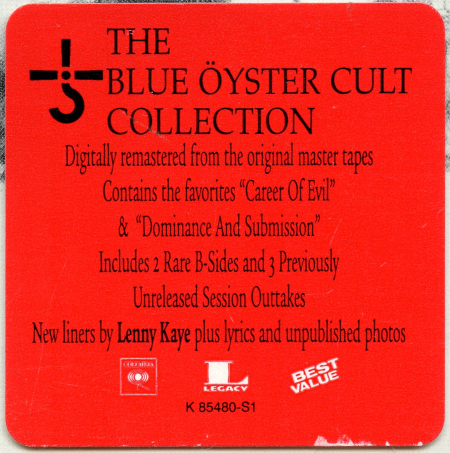
Blue Öyster Cult, Secret Treaties
Originally released 1974, reissued 2001 (Discogs) with four bonus tracks
When lyrics do not confirm the listener's arrogant presumption that he knows the person doing the singing—more precisely, that he knows what the singers means and that what the singers means is exactly what the singer thinks—when they are written by committee, so to speak, we can get past such personalized socio-politics and soak in the themes, moods, allusions, references. Blue Öyster Cult certainly offer a heady, rich brew of these. Though the band's direct connection to the budding New York Punk scene came via lyricist partners like Smith and Wheels, the lyrics do not overtly suggest similarities with Punk, but instead point back to the years of the band's long gestation process, 1967-1972, that is: when “turned on” “out front” youthful hippies, especially those who had missed out on the happier pre-1967 times, expected—no, demanded!—a revolution any day now. As the Cult sang in ‘R. U. Ready 2 Rock’: “I only live to be born again.”
Those years encompassed Blue Öyster Cult's beginnings as Soft White Underbelly, development of their Rock-band-as-art-project concept with their manager-mastermind Pearlman, and the recording and release of their self-titled debut album, which in its recording quality is significantly rawer than what was to come. While at times, as on fifth album Spectres' lead-off track and hit single, ‘Godzilla’, the Cult may harken back to the pre-hippie days, other common topics: motorcycle gangs, extraterrestrial life, alienated free-living cast-offs, fetishized sexuality, and conspiracy theories, definitely evoke the paranoia and social upheaval of those years. On top of that, throw in historical oddiments like the Royal Canadian Mounted Police and Mommie Dearest. Then add a healthy dose of fantastical themes, in some cases in collaboration with another lyricist: the novelist Michael Moorcock, most known in the Rock world for his work with Hawkwind. The end result is music that persistently triggers "heavy" thoughts, and what in the present day, for this listener at least, is the titilating feeling, perhaps only fleeting but strong nonetheless, that secrets are being revealed, forbidden subjects broached. Robertson Davies' novels evoke the same feeling, especially the Deptford Trilogy and What's Bred in the Bone. The cover of Agents of Fortune easily could have served as the cover of a Davies novel.
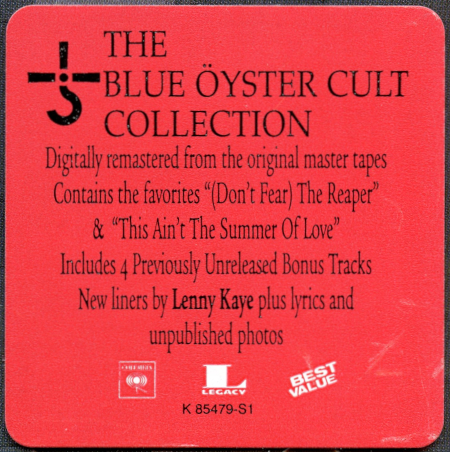
Blue Öyster Cult, Agents of Fortune
Originally released 1976, reissued 2001 (Discogs) with four bonus tracks
Spectres benefits most from the variation in lead vocals, with bassist Joe Bouchard and his brother, drummer Albert Bouchard, taking two star turns each, sequenced well alongside Bloom's and Roeser's lead vocals. Agents of Fortune, on the other hand, saw Albert sing three songs, two of them on the album's (relatively) lackluster side B; and with keyboardist-guitarist Allen Lanier taking a rare lead on ‘True Confessions’, the album overall does not achieve the balance between Bloom and Roeser that would become crucial to the band's later albums. Either way, a simple history may posit that these two albums witnessed the Cult going pop, a point suggested by the first-third albums comprising the band's "black-and-white" period, their (mostly) monochromatic covers reflecting their relatively-uniform "Rockist" sound. But this take on the band's history leaves out a lot. However more mainstream-oriented the music got, the lyrics in the late Seventies-early Eighties explored more speculative-fiction themes (horror, sci fi, and fantasy) than previously, making the band more “Prog” as well, whereas the criminal/ biker themes prevalent on the earlier albums fit in better with Metal and Punk. At the same time, while Agents of Fortune brought about new levels of commercial success, it also included more collaborations with Patti Smith, and it included what could easily have been a Punk anthem, its rousing opening track ‘This Ain't the Summer of Love’.
Except... Blue Öyster Cult work better as a link between the hippie and punk eras, soundtracking the disillusionment of those who invested too much in "mind-expanding" drugs, post-Psychedelic Rock, and the sexual revolution ("sex, drugs, and Rock-and-Roll," as the common phrase at the time went). Think of ‘This Ain't the Summer of Love’ as a theme song for 1967 and its mythical "summer of love," since any actual such season would have taken place in the winter of 1966, or maybe it was the summer—of 1964, if you were one of the Merry Pranksters. Except again... “love” is not the right word, it never was. Euphoria maybe. Really a drug-induced materialist Millenarianism transformed in the Seventies, in all those arenas and studios where the likes of Blue Öyster Cult played, into excess courting oblivion, justified by vague movements toward dissent and hints at alternate "lifestyles": in short, nonsense, at least compared to the music, which perseveres. So why not connect this turned-inward ("some get strong, some get strange") revolution to stories of schemers, cops and robbers, conspiracists, and otherworldly warriors? On one hand, showmanship and snake oil; on the other, a fun-house version of Roger Waters' Rock-music-as-fascism trope, offered up at the same time. Those cookie-cutter divisions between the hippies and the punks, or Heavy Metal and Punk, and so on, dissolve. "A veteran of a thousand psychic wars"—that sounds right after all. (Way back in 1973, in a Robert Christgau article on the band for Newsday [1, 2 and 3], the emphasis was on the "greasers" who liked heavier music, contrasted with the hippies, with the acknowledgement that the band members themselves were not greasers. Not dissimilar from the supposed divide, not too long ago, between townies and Indie-popster... gownies?)
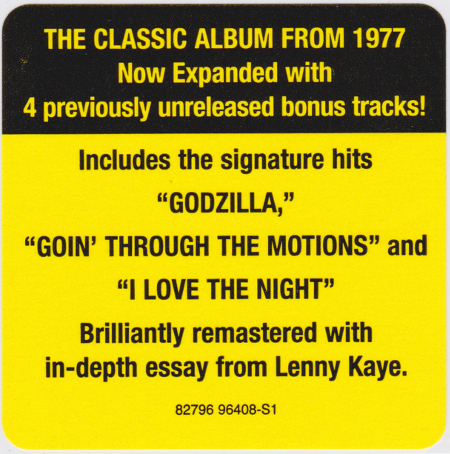
Blue Öyster Cult, Spectres
Originally released 1977, reissued 2007 (Discogs) with four bonus tracks
There were drawbacks to the band's collectivist and concept-centric approach. Verbosity has never gelled well with song composing, and plenty of awkward stuffing of words into tight musical structures have led to justified critiques of the limitations of Blue Öyster Cult's melodicism (for a contemporaneous example, see the New York Dolls). But I say, keep listening. I find myself, especially on the first-third albums, enjoying the rhythms and textures of the recordings so much that the songs seem to pass without me registering the melody or over-arching structure of the song. That is, they groove on by; they sound too good to pay close attention—like how you don't starting counting measures dancing to Techno music, though you could.
As the original five-piece fell apart; collective decisions perhaps came to reflect social tensions rather than artistic goals. Allen Lanier's main contribution to Fire of Unknown Origin, the closing track ‘Don't Turn Your Back’, has always been a dud to my ears. Indeed, that album's predecessors, Cultösaurus Erectus and Mirrors, both also feature one track too many (‘Hungry Boys’ and ‘Dr. Music’, respectively); the contrast with the picture-perfect sequencings of Tyranny and Mutation and Secret Treaties, nowadays held up as the band's best works, is clear. ‘Hungry Boys’ was drummer Albert Bouchard's lone lead vocal on Erectus, perhaps hinting at Albert's greater interest in crafting what would later become the band's eleventh album, Imaginos, derived from Pearlman's series of poems of the same name. (That album, meant to flesh out Pearlman's elaborate conspiratorial view of modern history, was released in 1988 after years of planning and a belabored production involving an excess of session musicians.) Things got a little worse on Revölution by Night, after which a disenchanted Lanier left, and a lot worse—the worst by far—on Club Ninja. The former at least contains ‘Take Me Away’, one of the greatest songs ever about humans welcoming alien abduction.

Blue Öyster Cult, The Columbia Albums Collection
Released 2012 (Discogs)
The brief essays that Lenny Kaye, compiler of Nuggets and guitarist for Patti Smith among other roles, contributes to these C. D. reissues are fine case studies of how to write reissue liner notes when the reader knows you're a friend of the band. The prose gets a bit purple at times, but we still find revealing historical notes: “The band kept a folder full of Meltzer's and Pearlman's word associations in their rehearsal room, and would leaf through it, setting fragments to music.” Kaye too informs us that, around the time of Agents of Fortune, each member of the group had their own home-recording set-up, allowing them to work on their own songs with greater independence. As we have seen, this change led first to a creative surge then the slow dissolution of the band.
Kaye both describes the music and the lyrics effectively. Regarding the former: "They were was as much Motor City boogie (Amboy Dukes) and Rebel boogie (post-Allman Brothers) as English midland crunch" (referring of course to Black Sabbath). On the latter: “Their cycle gang imagery - enhanced by the biker bar in Hempstead that became their haven, Conry's - had a futuristic feel, a Mad Max sense of mutant apocalypse that fit well with the emergent genre called Heavy Metal, a term bastardized from the writings of William Burroughs.” He adds, “Where some bands attempted to rabble-rouse, BÖC's concerns were more scientific, each song an abstract tale rather than a personal, emotionally wrenching narrative.” A fitting conclusion: “Though scaled to the gargantuan, the Cult never bludgeoned; instead, their music has a filigree delicacy amidst the decibels, the rhythms twisting and shifting, the guitar lines entwining, the lyrics tending toward the mythic and scientifictional.” Kaye more recently wrote the notes for the box set, The Columbia Albums Collection, definitely solidifying his status as one of those aforementioned officiants and gate keepers, welcoming those who embrace the Cult's stories about those seeking newfound freedoms only to lose the freedom they already had.
–Justin J. Kaw, June 2023